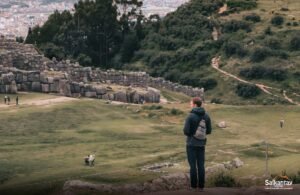A tour guide should research and plan the itinerary thoroughly before the tour. They must also confirm all bookings and arrangements in advance.
Embarking on the journey of a tour guide comes with the responsibility of not only knowing the destination but also ensuring a smooth and memorable experience for the guests. Effective preparation is crucial; it involves familiarizing oneself with the history, culture, and nuances of the attractions to be visited.
Preparing answers to potential questions and checking on the logistics of transport, accommodation, and entry tickets are essential steps. This front-end work makes the guide proficient and the tour seamless, allowing guests to immerse themselves in the sights without any distractions. This introduction sets the foundation for an engaging and trouble-free adventure, leaving lasting impressions on the travelers.
Table of Contents
Toggle- Introduction To Tour Guiding
- Research And Knowledge Update
- Itinerary Planning
- Risk Assessment And Management
- Liaise With Vendors And Partners
- Communication With Participants
- Equipment And Resource Check
- Personal Preparation
- Logistical Coordination
- Briefing The Team
- Final Review And Adjustments
- Frequently Asked Questions Of What Should A Tour Guide Do Before The Tour
- Conclusion
Introduction To Tour Guiding

Tour guiding is a vital element of the travel industry. A tour guide’s role extends beyond just showing places. They create memorable experiences for travelers by sharing insights, stories, and local knowledge. Before stepping out, there’s much to consider to ensure everything runs smoothly.
Getting The Role Of A Tour Guide
Becoming a tour guide involves more than knowing the route. A guide acts as a storyteller, safety officer, and the face of the destination. They must be equipped with facts, maintain the group’s interest, and handle unexpected situations with ease.
- Knowledge bearer of the tour destination
- In charge of safety and first aid
- Expert in crowd management
- Responsive to guest needs and inquiries
Importance Of Preparation For A Successful Tour
Preparation sets the stage for an outstanding tour. Thorough planning guarantees a smooth experience for both guests and guides. Let’s delve into what constitutes effective prep work.
- Research: Stay up to date with facts and stories.
- Route planning: Scout out the path for any changes.
- Weather checks: Plan for the day’s conditions.
- Equipment: Ensure communication devices and safety gear are ready.
An equipped and informed guide can transform a simple tour into an unforgettable journey.
Research And Knowledge Update

The success of any tour largely hinges on the guide’s preparation. Being up-to-date with the latest information ensures an enjoyable and seamless experience for everyone. A tour guide’s responsibility extends beyond just presenting rehearsed facts; it involves a continuous process of research and knowledge update. Here are essential steps for tour guides to take before setting foot on their guided adventure.
Studying The Latest Information About The Sites
Tour guides must thoroughly understand the sites they visit. This knowledge forms the backbone of an insightful tour. To ensure accuracy and engagement, guides should:
- Consult official sources – such as museum websites or historical archives – for recent discoveries or findings.
- Read updated guidebooks and articles – which might offer new perspectives or trivia that enliven the narrative.
- Engage with local communities – for firsthand stories and updates that may not be widely published.
Staying informed about the latest news, renovations, or historical interpretations adds depth to the storytelling.
Verifying Changes In Routes Or Accessible Areas
Routes and access points can change due to a variety of reasons. To ensure a smooth tour, a guide should:
- Check for construction updates – as these can alter paths or close down areas completely.
- Review entry policies – since sites may adjust their visiting hours or restrict access to certain areas for preservation purposes.
- Contact local authorities or site management – to receive the most current information on accessibility.
Verifying these updates beforehand prevents potential delays and disruptions, enhancing the overall tour experience.
Itinerary Planning
Before any tour kicks off, a well-thought-out plan is crucial. It sets the stage for memorable experiences. Well-planned itineraries ensure everything runs smoothly. They consider both the exciting activities and the necessary downtimes.
Creating A Detailed Tour Plan
A detailed tour plan works as a roadmap for travelers. It highlights major stops and attractions. Tour guides should ensure each spot offers unique value. They gather information about each location. This includes history, significance, and cultural aspects.
- Research each destination thoroughly.
- Estimate the time spent at each stop.
- Arrange activities accordingly.
- Provide background details to enrich the experience.
Maps and visuals aid in understanding routes. Guides should prepare these in advance. They can share itineraries with travelers. Feedback from past tours can refine new plans.
Incorporating Time For Rest And Questions
Balance is key in any successful itinerary. Including rest periods allows guests to recharge. This can be quick breaks or longer stops for meals. Space for questions and interactions enriches the experience.
| Activity | Duration | Rest/Question Time |
|---|---|---|
| Morning Walk | 2 hours | 30 minutes |
| Museum Tour | 1.5 hours | 20 minutes |
| City Exploration | 3 hours | 1 hour |
A blend of exciting sights and leisurely pauses keeps travelers engaged and relaxed. A Q&A session at each major point ensures deeper understanding. It also encourages participation.
Risk Assessment And Management

Before setting off on an exciting tour, a tour guide has one crucial task – risk assessment and management. This process ensures everyone’s safety and prepares for any unexpected events. Conducting a thorough check minimizes potential hazards and keeps the tour smooth and enjoyable for all.
Identifying Potential Risks
A tour guide must first identify what could go wrong. This involves looking at the tour itinerary closely and recognizing any possible dangers. Key areas might include transportation, destinations, activities, and group specifics, such as age and physical abilities. Let’s break down the critical steps in identifying risks:
- Review the route: Check for safe walkways and road crossings.
- Check the weather: Look for conditions that could impact the tour.
- Visit in advance: A pre-visit can reveal unforeseen issues.
- Research local advisories: Alerts about health, weather, or political unrest are important.
Preparing For Emergencies And Contingencies
After identifying risks, a tour guide must prepare a plan for emergencies. This includes first aid, evacuation routes, and backup plans for activities. A well-prepared guide is a beacon of confidence for travelers. Consider these steps for effective preparation:
| Action | Detail |
|---|---|
| First Aid Certification | Ensure up-to-date certification and first aid kit. |
| Emergency Contacts | Have a list of local emergency numbers and addresses. |
| Evacuation Plans | Know the quickest and safest routes out. |
| Activity Alternatives | Have backup plans if original activities are not possible. |
Liaise With Vendors And Partners
Preparing for a successful tour starts with effective coordination with your network of vendors and partners.
A tour guide’s to-do list should include essential liaisons with key contacts to confirm all the intricate details are in place.
This step guarantees guests experience a seamless journey from start to finish.
Confirming Reservations And Bookings
Stay ahead of the curve by double-checking even the smallest details well in advance.
Ensure all guests have confirmed spots at each tour stop.
- Contact hotels to confirm room reservations
- Verify transport arrangements
- Ensure meal bookings align with the tour schedule
- Check tickets for events or attractions
Accurate bookings prevent unpleasant surprises that can disrupt the flow of the tour.
Coordinating With Other Service Providers
Networking with service providers is key for a butter-smooth excursion.
Clear communication with all involved parties sets the stage for a successful outing.
| Provider | Service | Confirmation |
|---|---|---|
| Transport Companies | Timely Pick-ups | Confirmed |
| Restaurants | Group Seating Arrangements | Confirmed |
| Activity Operators | Equipment Readiness | Confirmed |
Secure a hassle-free travel day by cementing the organizational groundwork beforehand.
Communication With Participants
Effective communication sets the stage for a memorable tour experience. It ensures everyone is on the same page. Tour guides must reach out to participants before the journey begins. This includes sharing details and gathering participant information.
Sharing Itinerary And Expectations
A well-informed traveler is a happy one. Tour guides should provide a clear and detailed itinerary. This builds excitement and prepares participants for the adventure ahead. Key items to share:
- Meeting points and times
- Tour highlights to look forward to
- Breaks, meals, and free time
- Expected dress code and gear
Gathering Necessary Information From Participants
Understanding your group is vital. Collect essential details well ahead. Use
online forms for ease and convenience. Information to gather includes:
| Information Type | Details |
|---|---|
| Personal Information | Names, ages, and contact details |
| Medical Needs | Conditions, allergies, and medication |
| Dietary Restrictions | Preferences and forbidden foods |
| Emergency Contacts | Names and phone numbers |
Equipment And Resource Check
Before any tour begins, a crucial step for tour guides is to check their equipment and resources. This ensures a smooth experience. Guests expect an engaging, hassle-free tour. A well-prepared guide can provide just that. Below are essential checks every guide should complete.
Ensuring All Tools And Resources Are In Order
Organizing the necessary tools and resources is a must. This prevents delays and issues during the tour.
- Maps and itineraries should be ready and accessible.
- Check the first aid kit for all essentials.
- Tickets and passes for activities should be pre-arranged.
- Emergency contacts need to be up-to-date.
Preparing For Audiovisual Needs
Many tours require audiovisual tools to enhance the experience.
- Verify that all audio devices are charged and working.
- Test the microphone and speaker for clarity.
- Ensure any visual aids like projectors or tablets are functioning.
- Pack extra batteries or chargers for unexpected needs.
Personal Preparation

Being a tour guide is more than sharing history and showing sights. Personal preparation is crucial. This ensures a smooth experience for guests. Let’s dive into how guides can ready themselves.
Dressing Appropriately For The Tour
First impressions matter. Guides should look the part.
- Check the weather – be ready for rain or shine.
- Wear comfortable shoes – expect lots of walking.
- Pick outfits that reflect the tour theme.
- Always carry an extra layer for unexpected chill.
Ensuring Personal Wellbeing And Energy Levels
A guide’s energy can make or break a tour.
| Aspect | Action |
|---|---|
| Nutrition | Eat a balanced meal for sustained energy. |
| Hydration | Keep water at hand to stay refreshed. |
| Rest | Ensure a good night’s sleep before the day. |
| Mental Prep | Review the tour plan to stay sharp. |
Logistical Coordination
A successful tour hinges on impeccable logistics.
Tour guides must juggle a multitude of tasks to ensure a seamless experience.
Transportation Arrangement
Efficient transport forms the backbone of a great tour. Here’s how guides prepare:
- Booking in advance: Securing vehicles ahead of time guarantees availability.
- Vetting options: Choosing reliable transportation services is a must.
- Confirming details: Double-checking pickup times and locations prevents delays.
Checking Weather Forecasts And Adjusting Accordingly
Weather plays a crucial role:
- Monitor forecasts: Guides check predictions regularly.
- Plan B in place: Alternate activities are ready if needed.
- Inform travelers: Guests receive updates to prepare for any changes.
Briefing The Team
A successful tour hinges on a well-prepared guide and an informed team. Briefing the team before setting out is crucial.
Aligning Team Members With The Tour’s Objective
Before embarking on a tour, every guide must ensure that their team understands the tour’s main goal. This clarity aids in providing guests with a coherent and focused experience.
- Identify the key message or theme of the tour.
- Communicate the desired outcome to all team members.
- Address any concerns that may distract from the tour’s objective.
Discussing Roles And Responsibilities
A team that knows their roles can work smoothly. Let’s define who does what.
| Team Member | Role Description |
|---|---|
| Lead Guide | Manages the tour, shares insights, and engages with guests. |
| Assistant Guide | Supports the lead guide and handles logistical aspects. |
| Driver | Ensures safe transport and adheres to the schedule. |
Clear understanding of each duty ensures a seamless tour experience for visitors.
Final Review And Adjustments
Preparing for a tour involves careful planning and attention to detail. It’s crucial that tour guides conduct a final review and make necessary adjustments before setting off. This ensures a smooth and enjoyable experience for guests. As part of the last checks, reevaluating the tour plan and making last-minute changes are essential steps to address any unforeseen challenges or opportunities.
Reevaluating The Tour Plan
Every good tour guide knows the importance of going over their plan one more time. This check involves confirming details like times, locations, and activities. It’s also the perfect moment to check weather forecasts and event schedules to ensure they align with the tour’s itinerary. Reevaluation helps in identifying areas that might need a quick tweak for improvement.
- Verify opening hours for attractions
- Check for special events or closures
- Update safety protocols if needed
Making Last-minute Changes If Necessary
Flexibility is key in tour guiding. Should issues arise, a prompt response is necessary. Last-minute changes might include altering the route to avoid traffic or construction. It might also mean adding a spontaneous stop that could enrich the tour. Ensuring guest comfort and interest are at the forefront can sometimes call for immediate action.
- Route adjustments to bypass delays
- Adding exciting, unplanned stops or activities
- Providing alternatives for unavailable attractions
Frequently Asked Questions Of What Should A Tour Guide Do Before The Tour
What Is Pre Tour In Tour Guiding?
A pre-tour in tour guiding refers to the preparatory stage where guides familiarize themselves with the itinerary, sights, and logistics before leading the actual tour.
What Should A Tour Guide Do?
A tour guide should provide interesting information about attractions, manage schedules efficiently, ensure safety, interact engagingly with tourists, and handle emergencies promptly.
What Is The Preparation Process When Leading A Group Tour?
Initiate by researching and choosing a compelling tour destination. Create a detailed itinerary that includes all activities and timeframes. Secure accommodations and transportation well in advance. Gather necessary equipment and supplies for the group. Provide pre-tour information to participants, addressing safety and expectations.
How Do You Start An Introduction For A Tour Guide?
Welcome to our tour! I’m [Your Name], your guide for this adventure. Let’s embark on an unforgettable journey, exploring the hidden gems and popular spots our destination has to offer. Ready to create some memories? Let’s dive in!
Conclusion
Preparing effectively sets the stage for a memorable and informative tour experience. As a tour guide, ticking all the boxes on your pre-tour checklist ensures a smooth journey. From researching diligently to engaging with your audience beforehand, each step is pivotal.
Remember, your preparation doesn’t just begin the journey; it defines it.



